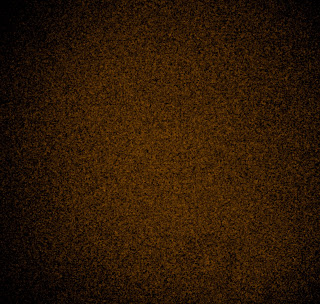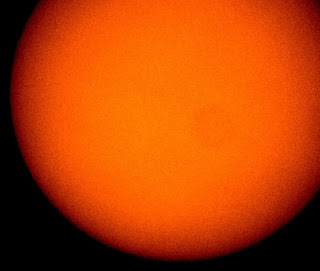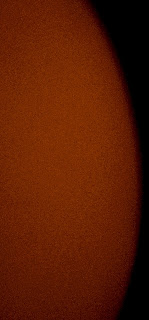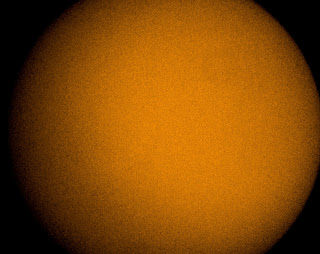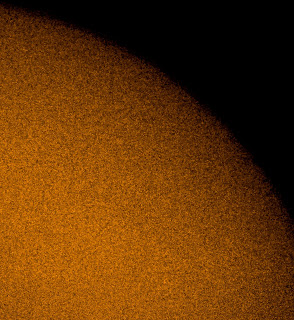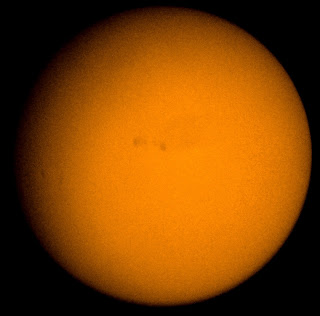April 28th 2010 GMT
The sky was mostly clear and the crescent moon was in the west accompanied by Aldebaran. I used my DSLR at ISO400 and 1/1000 second exposure to take the Moon and at 3 seconds exposure to include Aldebaran.
I stacked 62 moon frames to get this.
With the exposure at 3 seconds, I tried to capture Jupiter's moons
Finally, I took some star trails that were partially ruined by cloud.
April 27th 0750 GMT
I bin scanned the Sun through thin cloud and did not see any sunspots.
April 26th 1320 GMT
Conditions were mostly cloudy but I caught a clear patch and could see two sunspots. A third one was visible on the professional images but I could not see it with my binoculars.
April 25th 0745 GMT
I bin scanned the Sun but was unable to see any of the recent sunspots.
April 23rd 1110 GMT
I took a hydrogen alpha shoot with my PST. I could see the two sunspots but cloud rolled in before I could take any close-up shots.
April 23rd 1000 GMT
I bin scanned the Sun in a clear sky and could see both sunspots.
April 22nd 1100 GMT
I bin scanned the Sun and followed up with a hydrogen alpha shoot.
Ironically enough, the binoculars only showed a single sunspot, whereas I could see two in my Coronado PST. The drawing is a composite of both views.
April 20th 1200 GMT
I bin scanned the Sun in cloudy conditions but was unable to see the recent sunspots.
April 19th 1020 GMT
I checked the Sun in hydrogen alpha light. The Sun was quiet but I could see sunspots where I had seen the flare the day before.
April 19th 0650 GMT
I bin scanned the Sun, hoping to see the new sunspot activity but it was below my binoculars' resolution.
I used my DSLR at 300mm at ISO400 to take some lunar photos. The first set of frames at 1/1000 second exposure lightened the sky background too much. I obtained the lunar images at 1/4000 second exposure.
April 18th 0930 GMT
I checked the Sun in hydrogen alpha light with my PST. I could see a flare rotating onto the solar disc but it was otherwise quiet.
April 16th 1015 GMT
I checked the Sun in hydrogen alpha light again. As the day before, I did not see any large-scale structures but saw some shading. I managed only full disc frames before cloud moved in.
April 15th 1230 GMT
A brief break in the cloud gave me a window of opportunity to view the Sun in hydrogen alpha light. It was still quiet but I could see some lighter and darker regions. Unfortunately, cloud rolled in again, preventing me from taking a full rage of shots.
April 11th 1150 GMT
Against all odds, there was a gap in the clouds, so I was able to perform the solar hydrogen alpha shoot that I was unable to do earlier.
April 11th 0810 GMT
The real-time solar images on SOHO showed a new sunspot but it was not visible in my binoculars. I followed up with a hydrogen alpha view with my PST. The solar disc was bland. I was unable to take any photos because cloud rolled in.
April 10th 1000 GMT
With cloudy weather forecast, I caught a rare clear spell to check the Sun in hydrogen alpha light. The Sun still appeared rather quiet.
April 9th 1005 GMT
I checked the Sun in hydrogen alpha with my PST. It appeared to have some surface shading, in contrast to the previous two days, so I took some close-ups as well as the full disc shots.
April 8th 0845 GMT
As the day before, the Sun appeared totally bland in hydrogen alpha light. I just took some full disc frames.
April 7th 2010 GMT
At last, I had an evening that was warm enough to go out long after sunset. I started off my snapping the Moon with my Mak and DSLR. I used ISO 400 and 1/1000 second exposure. I took 138 frames, stacked them using Microsoft ICE and finished in GIMP. To be honest, I was rather pleased.
I finished off with Jupiter and Mizar/Alcor with the DSLR at 300mm focal length, 3 seconds exposure and ISO 6400.
April 7th 1045 GMT
I checked the Sun with my PST. Even in hydrogen alpha light, the Sun was as bland and featureless as I'd ever seen it. Even re-tuning the etalon did not reveal any detail.
April 7th 0655 GMT
I bin scanned the Sun in clear conditions but did not see any sunspots.
April 6th 1640 GMT
With cloud and cold predicted for the evening, I shot the Moon with my DSLR and Mak. I had to do a bit of cloud dodging but managed to take 138 frames. I use ISO400 and 1/200 second exposure.
April 6th 0945 GMT
In contrast to the weather forecast, the clouds cleared and I was able to do a solar hydrogen alpha shoot with my PST Unfortunately, the Sun was quiet after all the excitement of the sunspots of the previous few days. Scientifically, it was interesting but we solar amateurs like to see an active Sun with lots of features.
April 6th 0650 GMT
I bin scanned the Sun in clear conditions but did not see any sunspots.
April 5th 1145 GMT
There was some haze around, unlike the clear conditions earlier but it had warmed up considerably. I checked the Sun in hydrogen alpha light with my PST. Apart from the sunspots, it was very quiet.
April 5th 0655 GMT
It was cold and clear, so I bin scanned the Sun. The sunspot region was rotating close tom the limb and appeared as two single, large sunspots.
April 3rd 0740 GMT
Conditions were somewhat hazy but cloud was forecast for later in the day. A solar bin scan revealed that the sunspot group had changed but it was starting to get close to the solar limb. The smaller group was no longer visible to my binoculars.
April 2nd 1755 GMT
I took a quick sequence of lunar shots with my DSLR only at 300mm focal length 1/200 second exposure and ISO 400.
April 2nd 1500 GMT
If there's anything more sure to drive one mad than webcamming, it is doing it without a GOTO driven mount. I tried webcamming both the Sun and Moon using my Maksutov and Bresser electronic eyepiece. I had terrible trouble getting focus and needed to take a few test shots with background objects. Due to weather and illness, it was only the second time I had tried webcamming in 2017.Only one image caught any sunspot patterns.
However, I managed to stack 114 of 139 images using the MAK and DSLR to get this full disc image.
April 2nd 0820 GMT
I started off with a hydrogen alpha visual and photo shoot. Although the Sun was still rather quiet, I could still see sunspots and I could also see a flare. A quick glance through the frames showed that I'd actually managed to catch it on "film" on at least some of them.
I needed the red channel on the full disc shot to show the flare.
April 1st 1120 GMT
I had another long spell before cloud rolled in and tried another hydrogen alpha shoot. In addition to my usual full disc and quadrant shots, I also took some close-ups at even higher magnification, in an attempt to see if I could find some even smaller features.
April 1st 1110 GMT
The weather was best described as "changeable" . There were cloudy spells,, as the day before.with brighter spells in between. I decided to go for ISO 400 and 1/4000 second exposure, with my Mak and DSLR.
The sunspots were clearly visible in he finderscope and I took 103 frames, hoping for a stack. I didn't get a stack but managed a better single frame result than I did two days before.
It was straight to the PST and compact digital camera. The Sun appeared quiet, apart from the sunspots but I was hoping that the camera had caught a prominence, that I hadn't seen, as the day before. I only managed some full disc frames before cloud rolled in.





















